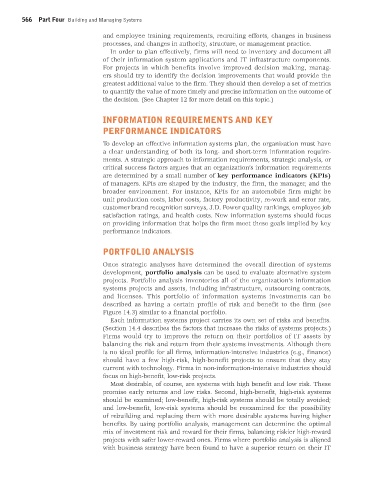Page 567 -
P. 567
566 Part Four Building and Managing Systems
and employee training requirements, recruiting efforts, changes in business
processes, and changes in authority, structure, or management practice.
In order to plan effectively, firms will need to inventory and document all
of their information system applications and IT infrastructure components.
For projects in which benefits involve improved decision making, manag-
ers should try to identify the decision improvements that would provide the
greatest additional value to the firm. They should then develop a set of metrics
to quantify the value of more timely and precise information on the outcome of
the decision. (See Chapter 12 for more detail on this topic.)
INFORMATION REQUIREMENTS AND KEY
PERFORMANCE INDICATORS
To develop an effective information systems plan, the organization must have
a clear understanding of both its long- and short-term information require-
ments. A strategic approach to information requirements, strategic analysis, or
critical success factors argues that an organization’s information requirements
are determined by a small number of key performance indicators (KPIs)
of managers. KPIs are shaped by the industry, the firm, the manager, and the
broader environment. For instance, KPIs for an automobile firm might be
unit production costs, labor costs, factory productivity, re-work and error rate,
customer brand recognition surveys, J.D. Power quality rankings, employee job
satisfaction ratings, and health costs. New information systems should focus
on providing information that helps the firm meet these goals implied by key
performance indicators.
PORTFOLIO ANALYSIS
Once strategic analyses have determined the overall direction of systems
development, portfolio analysis can be used to evaluate alternative system
projects. Portfolio analysis inventories all of the organization’s information
systems projects and assets, including infrastructure, outsourcing contracts,
and licenses. This portfolio of information systems investments can be
described as having a certain profile of risk and benefit to the firm (see
Figure 14.3) similar to a financial portfolio.
Each information systems project carries its own set of risks and benefits.
(Section 14.4 describes the factors that increase the risks of systems projects.)
Firms would try to improve the return on their portfolios of IT assets by
balancing the risk and return from their systems investments. Although there
is no ideal profile for all firms, information-intensive industries (e.g., finance)
should have a few high-risk, high-benefit projects to ensure that they stay
current with technology. Firms in non-information-intensive industries should
focus on high-benefit, low-risk projects.
Most desirable, of course, are systems with high benefit and low risk. These
promise early returns and low risks. Second, high-benefit, high-risk systems
should be examined; low-benefit, high-risk systems should be totally avoided;
and low-benefit, low-risk systems should be reexamined for the possibility
of rebuilding and replacing them with more desirable systems having higher
benefits. By using portfolio analysis, management can determine the optimal
mix of investment risk and reward for their firms, balancing riskier high-reward
projects with safer lower-reward ones. Firms where portfolio analysis is aligned
with business strategy have been found to have a superior return on their IT
MIS_13_Ch_14_global.indd 566 1/17/2013 2:31:59 PM

